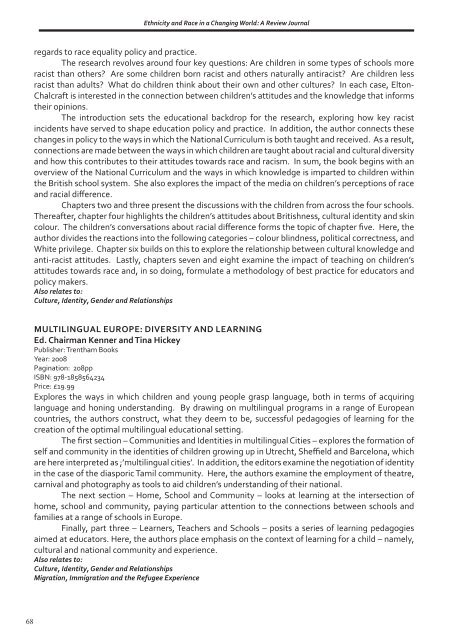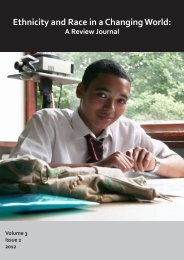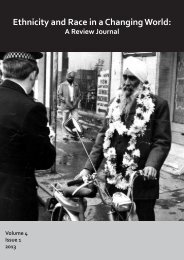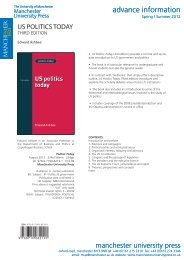Ethnicity and Race in a Changing World
Volume 2, Issue 1, 2010 - Manchester University Press
Volume 2, Issue 1, 2010 - Manchester University Press
- No tags were found...
Create successful ePaper yourself
Turn your PDF publications into a flip-book with our unique Google optimized e-Paper software.
<strong>Ethnicity</strong> <strong>and</strong> <strong>Race</strong> <strong>in</strong> a Chang<strong>in</strong>g <strong>World</strong>: A Review Journalregards to race equality policy <strong>and</strong> practice.The research revolves around four key questions: Are children <strong>in</strong> some types of schools moreracist than others? Are some children born racist <strong>and</strong> others naturally antiracist? Are children lessracist than adults? What do children th<strong>in</strong>k about their own <strong>and</strong> other cultures? In each case, Elton-Chalcraft is <strong>in</strong>terested <strong>in</strong> the connection between children’s attitudes <strong>and</strong> the knowledge that <strong>in</strong>formstheir op<strong>in</strong>ions.The <strong>in</strong>troduction sets the educational backdrop for the research, explor<strong>in</strong>g how key racist<strong>in</strong>cidents have served to shape education policy <strong>and</strong> practice. In addition, the author connects thesechanges <strong>in</strong> policy to the ways <strong>in</strong> which the National Curriculum is both taught <strong>and</strong> received. As a result,connections are made between the ways <strong>in</strong> which children are taught about racial <strong>and</strong> cultural diversity<strong>and</strong> how this contributes to their attitudes towards race <strong>and</strong> racism. In sum, the book beg<strong>in</strong>s with anoverview of the National Curriculum <strong>and</strong> the ways <strong>in</strong> which knowledge is imparted to children with<strong>in</strong>the British school system. She also explores the impact of the media on children’s perceptions of race<strong>and</strong> racial difference.Chapters two <strong>and</strong> three present the discussions with the children from across the four schools.Thereafter, chapter four highlights the children’s attitudes about Britishness, cultural identity <strong>and</strong> sk<strong>in</strong>colour. The children’s conversations about racial difference forms the topic of chapter five. Here, theauthor divides the reactions <strong>in</strong>to the follow<strong>in</strong>g categories – colour bl<strong>in</strong>dness, political correctness, <strong>and</strong>White privilege. Chapter six builds on this to explore the relationship between cultural knowledge <strong>and</strong>anti-racist attitudes. Lastly, chapters seven <strong>and</strong> eight exam<strong>in</strong>e the impact of teach<strong>in</strong>g on children’sattitudes towards race <strong>and</strong>, <strong>in</strong> so do<strong>in</strong>g, formulate a methodology of best practice for educators <strong>and</strong>policy makers.Also relates to:Culture, Identity, Gender <strong>and</strong> RelationshipsMULTILINGUAL EUROPE: DIVERSITY AND LEARNINGEd. Chairman Kenner <strong>and</strong> T<strong>in</strong>a HickeyPublisher: Trentham BooksYear: 2008Pag<strong>in</strong>ation: 208ppISBN: 978-1858564234Price: £19.99Explores the ways <strong>in</strong> which children <strong>and</strong> young people grasp language, both <strong>in</strong> terms of acquir<strong>in</strong>glanguage <strong>and</strong> hon<strong>in</strong>g underst<strong>and</strong><strong>in</strong>g. By draw<strong>in</strong>g on multil<strong>in</strong>gual programs <strong>in</strong> a range of Europeancountries, the authors construct, what they deem to be, successful pedagogies of learn<strong>in</strong>g for thecreation of the optimal multil<strong>in</strong>gual educational sett<strong>in</strong>g.The first section – Communities <strong>and</strong> Identities <strong>in</strong> multil<strong>in</strong>gual Cities – explores the formation ofself <strong>and</strong> community <strong>in</strong> the identities of children grow<strong>in</strong>g up <strong>in</strong> Utrecht, Sheffield <strong>and</strong> Barcelona, whichare here <strong>in</strong>terpreted as ;’multil<strong>in</strong>gual cities’. In addition, the editors exam<strong>in</strong>e the negotiation of identity<strong>in</strong> the case of the diasporic Tamil community. Here, the authors exam<strong>in</strong>e the employment of theatre,carnival <strong>and</strong> photography as tools to aid children’s underst<strong>and</strong><strong>in</strong>g of their national.The next section – Home, School <strong>and</strong> Community – looks at learn<strong>in</strong>g at the <strong>in</strong>tersection ofhome, school <strong>and</strong> community, pay<strong>in</strong>g particular attention to the connections between schools <strong>and</strong>families at a range of schools <strong>in</strong> Europe.F<strong>in</strong>ally, part three – Learners, Teachers <strong>and</strong> Schools – posits a series of learn<strong>in</strong>g pedagogiesaimed at educators. Here, the authors place emphasis on the context of learn<strong>in</strong>g for a child – namely,cultural <strong>and</strong> national community <strong>and</strong> experience.Also relates to:Culture, Identity, Gender <strong>and</strong> RelationshipsMigration, Immigration <strong>and</strong> the Refugee Experience68






